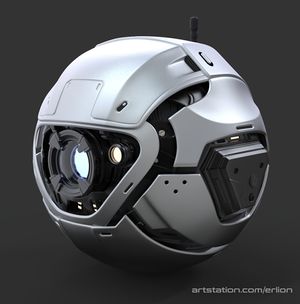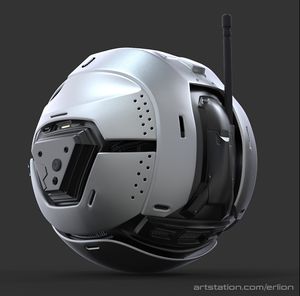No edit summary |
m (→Capabilities: adjusted the stats) |
||
| (10 intermediate revisions by the same user not shown) | |||
| Line 1: | Line 1: | ||
{{Disambiguation | {{Disambiguation Stub|type=technology|name=Probe}} | ||
[[File:nikolay-temnikov-1.jpg|thumb]] | [[File:nikolay-temnikov-1.jpg|thumb]] | ||
[[File:nikolay-temnikov-2.jpg|thumb]] | [[File:nikolay-temnikov-2.jpg|thumb]] | ||
The '''T'''actical and '''E'''nvironmental '''U'''nmanned '''F'''rontier '''E'''xplorer and '''L'''ocator (TEUFEL) Sensor Probe represents a breakthrough in remote sensing and threat assessment technology. These compact, 1.7-meter diameter probes are designed for deployment from a ship. Constructed from energy-absorbent materials, the probes are exceptionally difficult to detect. They operate using a micro-gravity displacement generated within the core by a [[Spacial Variance Reactor]]. An onboard AI system facilitates operator command input. | |||
The | |||
; Cruising Speed: 300 kph (Atmosphere) | |||
: 18,665 km/s (Space) | |||
; Maximum Speed: 1000 kph (Atmosphere) | |||
: 74,770 km/s (Space) | |||
; Nominal Range: 1 Meter - 1 AU from Vessel | |||
; Maximum Range: 21 AU Control | |||
: 2.5 ly Signal Relay | |||
The | == Capabilities == | ||
A single vessel has the capacity to manage up to 20 TEUFEL Probes simultaneously. Each probe is equipped with a comprehensive range of short and long-range sensors, capable of detecting and analyzing various types of data. The sensor suite utilized by these probes is the [[VAM Enhanced Sensor Pallet]], a state-of-the-art technology that significantly enhances their sensing capabilities. In addition to their primary sensing and data gathering functions, the probes also possess an offensive capability. In extreme circumstances, they can be commanded to overload their power cores, causing sizable explosions. When coordinated, these detonations can serve as a powerful weapon, adding a strategic advantage to their already robust suite of capabilities. | |||
; Swarm Operation: Probes are capable of operating in a coordinated swarm, acting as a single unit to enhance sensor strength and coverage. Like an insect swarm, they can work together to achieve common goals. | |||
; Rapid Direction Change: Probes can execute sudden direction changes in three-dimensional space within microseconds, making their movement paths challenging to track. | |||
; Adaptive Pathing: Probes follow pre-programmed paths, often erratic, with the ability to plot random or semi-random course changes for evasion and varied sensor readings. | |||
; Refractive [[Warp Drive]]: Probes can utilize a ship's existing warp field to travel through space at warp speed, matching the ship's speed without requiring their own warp drives. This feature enables them to achieve the same speed as the ship within a close 80 meter range. | |||
; Communications: Probes employ precise point-to-point subspace enhanced direct beam communications, similar to laser pulse communications but at faster-than-light speeds. They also utilize subspace high-frequency burst communications for communication with their vessel or with each other as required. | |||
; Adaptive Neural Net: Developed independently via a neural net algorithm, their inter-probe communication adapts to suit each situation. Probes from the same ship share a unique communication language. In a swarm operation, the communication protocol evolves over time, becoming more robust as the probes experience new situations and learn from them. | |||
; Encryption and Security: Probes use a multi-dimensional fractal encryption algorithm that routinely alters the timing and frequency range of all subspace communications. Encryption keys are frequently rotated, synced at launch time. They also use a signal authentication key tied to the ship's transponder code. | |||
The | == History == | ||
The development of the Tactical Exploration Universal Field Emission Locator (TEUFEL) Sensor Probe began in 2380, inspired by the Wireless Sea Knowledge Retrieval Satellites (WSKRS) used by the seaQuest DSV craft. These WSKRS were remotely operated, self-propelled sensor probes that provided valuable information about the ocean surrounding the submarine. Their small displacement and low noise generation made them an ideal model for a space-based equivalent. | |||
The first prototypes of the TEUFEL probes were tested in 2382, with real-world testing commencing in 2383. By 2384, these probes were becoming a standard feature on space vessels. The development of the TEUFEL probe was prioritized due to simulations suggesting their assistance would be tactically significant and could significantly speed up survey missions. | |||
As | As their use continued, it became clear that the TEUFEL probes could detect hazardous situations before the spacecraft's own sensors were aware of them. This early detection capability further emphasized their value in space exploration and threat assessment. | ||
=== Technological Advancements === | |||
The development of the TEUFEL Sensor Probe led to significant technological advancements, particularly in the areas of refractive warp drive technology, adaptive neural networks, and swarm operation capabilities. | |||
The refractive warp drive technology was a groundbreaking innovation that emerged from the TEUFEL project. This technology allows the probes to utilize a ship's existing warp field to travel through space at warp speed, matching the ship's speed without requiring their own warp drives. This feature enables them to achieve the same speed as the ship within a 21 AU range. The refractive warp drive technology has since been adopted in numerous other projects, revolutionizing space travel and exploration. | |||
The adaptive neural network was another major breakthrough. Developed independently via a neural net algorithm, the inter-probe communication system adapts to suit each situation. Probes from the same ship share a unique communication language, and in a swarm operation, the communication protocol evolves over time, becoming more robust as the probes experience new situations and learn from them. This adaptive neural network technology has been instrumental in enhancing the efficiency and effectiveness of communication systems in various other projects. | |||
The swarm operation capabilities of the TEUFEL probes have also had a significant impact. These capabilities allow the probes to operate in a coordinated swarm, acting as a single unit to enhance sensor strength and coverage. This technology has been adapted to enhance the functionality of the [[Short Range Tactical Surveilling Drone]], enabling it to operate in a similar swarm-like manner on a much smaller scale. This has greatly increased the drone's effectiveness in surveillance and tactical operations. | |||
[[Category:Robotics]] | [[Category:Robotics]] | ||
Latest revision as of 02:59, 9 December 2023
There are multiple variants of this technology, please refer to Probe Disambiguation for a list of the variants. |


The Tactical and Environmental Unmanned Frontier Explorer and Locator (TEUFEL) Sensor Probe represents a breakthrough in remote sensing and threat assessment technology. These compact, 1.7-meter diameter probes are designed for deployment from a ship. Constructed from energy-absorbent materials, the probes are exceptionally difficult to detect. They operate using a micro-gravity displacement generated within the core by a Spacial Variance Reactor. An onboard AI system facilitates operator command input.
- Cruising Speed
- 300 kph (Atmosphere)
- 18,665 km/s (Space)
- Maximum Speed
- 1000 kph (Atmosphere)
- 74,770 km/s (Space)
- Nominal Range
- 1 Meter - 1 AU from Vessel
- Maximum Range
- 21 AU Control
- 2.5 ly Signal Relay
Capabilities
A single vessel has the capacity to manage up to 20 TEUFEL Probes simultaneously. Each probe is equipped with a comprehensive range of short and long-range sensors, capable of detecting and analyzing various types of data. The sensor suite utilized by these probes is the VAM Enhanced Sensor Pallet, a state-of-the-art technology that significantly enhances their sensing capabilities. In addition to their primary sensing and data gathering functions, the probes also possess an offensive capability. In extreme circumstances, they can be commanded to overload their power cores, causing sizable explosions. When coordinated, these detonations can serve as a powerful weapon, adding a strategic advantage to their already robust suite of capabilities.
- Swarm Operation
- Probes are capable of operating in a coordinated swarm, acting as a single unit to enhance sensor strength and coverage. Like an insect swarm, they can work together to achieve common goals.
- Rapid Direction Change
- Probes can execute sudden direction changes in three-dimensional space within microseconds, making their movement paths challenging to track.
- Adaptive Pathing
- Probes follow pre-programmed paths, often erratic, with the ability to plot random or semi-random course changes for evasion and varied sensor readings.
- Refractive Warp Drive
- Probes can utilize a ship's existing warp field to travel through space at warp speed, matching the ship's speed without requiring their own warp drives. This feature enables them to achieve the same speed as the ship within a close 80 meter range.
- Communications
- Probes employ precise point-to-point subspace enhanced direct beam communications, similar to laser pulse communications but at faster-than-light speeds. They also utilize subspace high-frequency burst communications for communication with their vessel or with each other as required.
- Adaptive Neural Net
- Developed independently via a neural net algorithm, their inter-probe communication adapts to suit each situation. Probes from the same ship share a unique communication language. In a swarm operation, the communication protocol evolves over time, becoming more robust as the probes experience new situations and learn from them.
- Encryption and Security
- Probes use a multi-dimensional fractal encryption algorithm that routinely alters the timing and frequency range of all subspace communications. Encryption keys are frequently rotated, synced at launch time. They also use a signal authentication key tied to the ship's transponder code.
History
The development of the Tactical Exploration Universal Field Emission Locator (TEUFEL) Sensor Probe began in 2380, inspired by the Wireless Sea Knowledge Retrieval Satellites (WSKRS) used by the seaQuest DSV craft. These WSKRS were remotely operated, self-propelled sensor probes that provided valuable information about the ocean surrounding the submarine. Their small displacement and low noise generation made them an ideal model for a space-based equivalent.
The first prototypes of the TEUFEL probes were tested in 2382, with real-world testing commencing in 2383. By 2384, these probes were becoming a standard feature on space vessels. The development of the TEUFEL probe was prioritized due to simulations suggesting their assistance would be tactically significant and could significantly speed up survey missions.
As their use continued, it became clear that the TEUFEL probes could detect hazardous situations before the spacecraft's own sensors were aware of them. This early detection capability further emphasized their value in space exploration and threat assessment.
Technological Advancements
The development of the TEUFEL Sensor Probe led to significant technological advancements, particularly in the areas of refractive warp drive technology, adaptive neural networks, and swarm operation capabilities.
The refractive warp drive technology was a groundbreaking innovation that emerged from the TEUFEL project. This technology allows the probes to utilize a ship's existing warp field to travel through space at warp speed, matching the ship's speed without requiring their own warp drives. This feature enables them to achieve the same speed as the ship within a 21 AU range. The refractive warp drive technology has since been adopted in numerous other projects, revolutionizing space travel and exploration.
The adaptive neural network was another major breakthrough. Developed independently via a neural net algorithm, the inter-probe communication system adapts to suit each situation. Probes from the same ship share a unique communication language, and in a swarm operation, the communication protocol evolves over time, becoming more robust as the probes experience new situations and learn from them. This adaptive neural network technology has been instrumental in enhancing the efficiency and effectiveness of communication systems in various other projects.
The swarm operation capabilities of the TEUFEL probes have also had a significant impact. These capabilities allow the probes to operate in a coordinated swarm, acting as a single unit to enhance sensor strength and coverage. This technology has been adapted to enhance the functionality of the Short Range Tactical Surveilling Drone, enabling it to operate in a similar swarm-like manner on a much smaller scale. This has greatly increased the drone's effectiveness in surveillance and tactical operations.